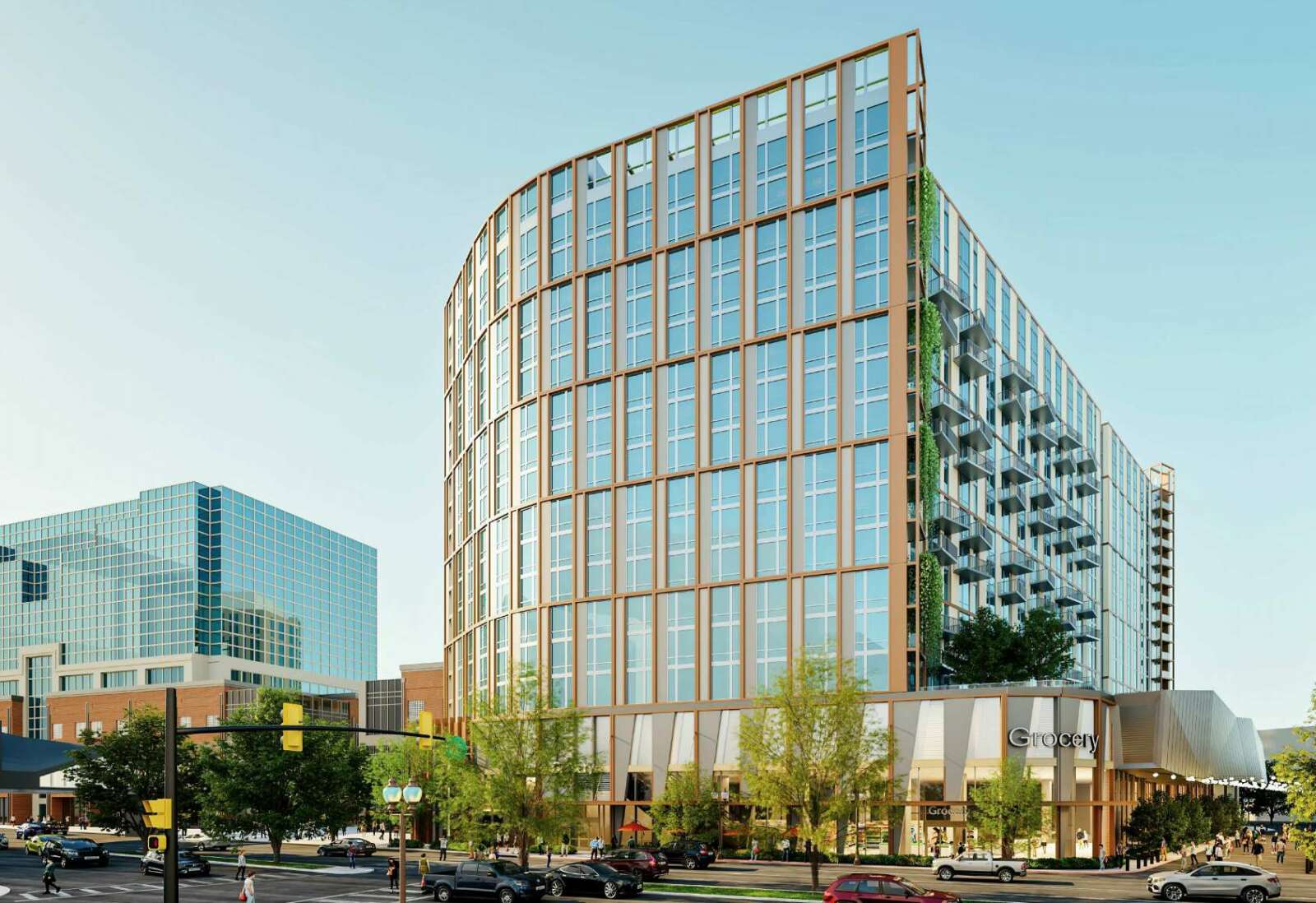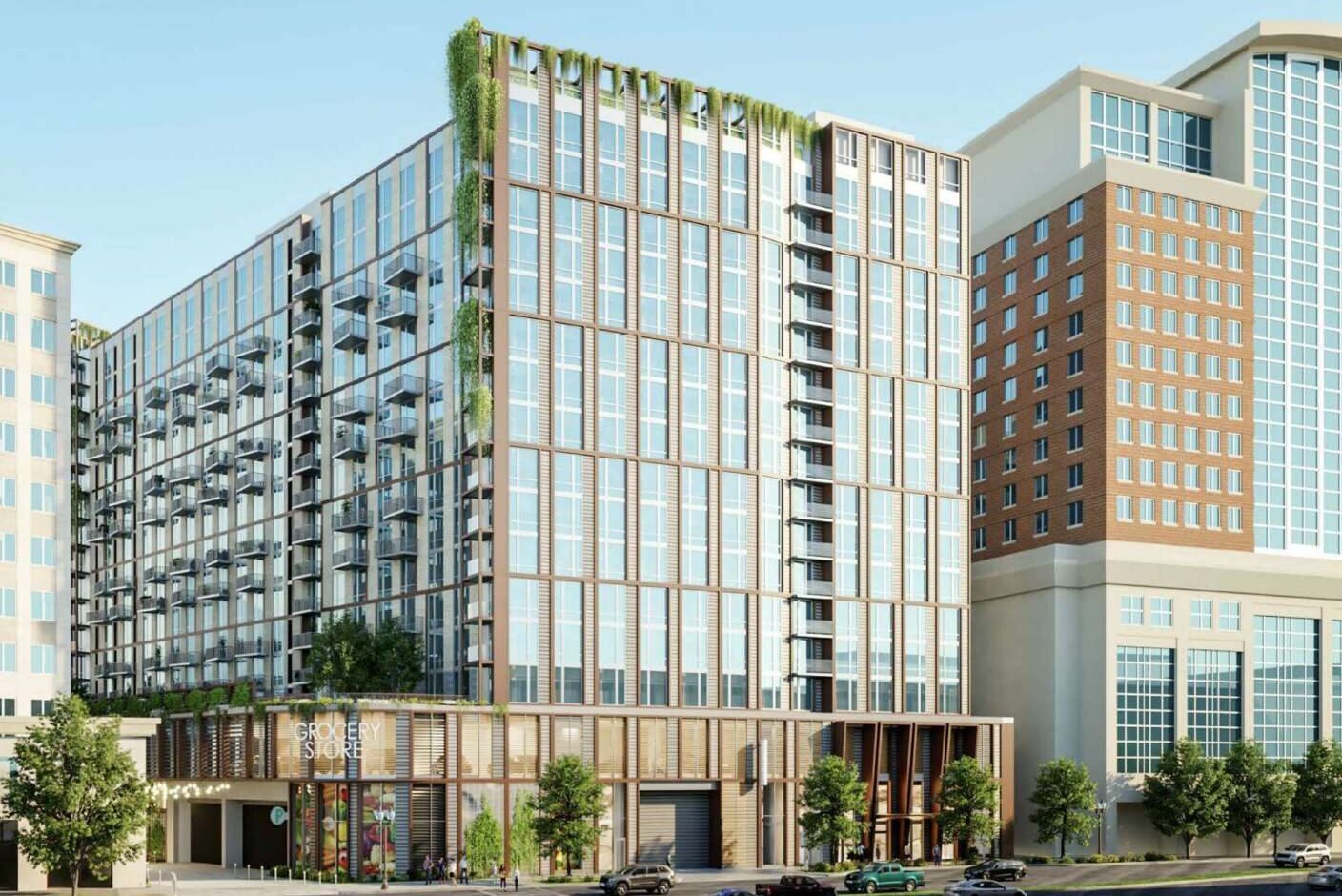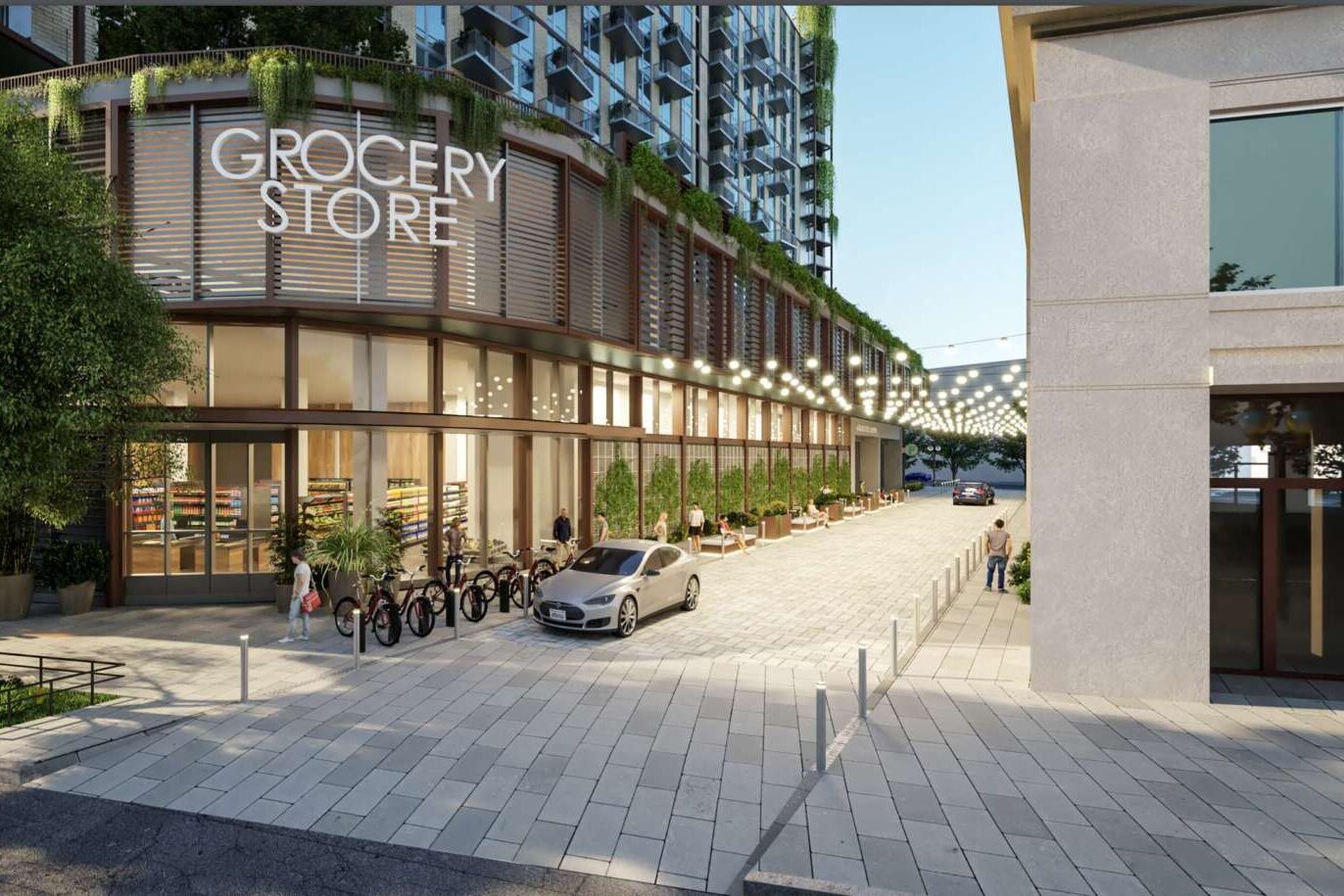Concerns are emerging about a proposed residential redevelopment that would replace the Macy’s in Ballston.
Insight Property Group proposes to demolish the longtime department store and vacant office building at 685 N. Glebe Road and replace it with a 16-story, 555-unit apartment complex atop a grocery store. In response to online engagement, it is adding a second, 1,400-square-foot retail space on the ground floor.
The units would be spread across two 14-story towers joined at the penthouse level. Residents would have 250 underground parking spaces while grocery store patrons would have 148 spots on the building’s second story.
Insight is considering how to celebrate the building’s history as part of the D.C. area’s first indoor regional shopping center, built in 1950, possibly by preserving some tiling and stairwells.
But during the first Site Plan Review Committee meeting last week, the proposal elicited apprehension from community members about density, from Planning Commissioners about community benefits, and county planners about cohesion with the rest of the mall.
Insight proposes to use two mechanisms to earn the right to build 275 additional units on top of the base density allowed for the site of 280 units. First, by using a novel zoning tool called a Transfer of Development Rights, it can tack on another 236 units.
The TDR rewards developers who commit to preserving affordable housing, open spaces, historic sites and community facilities on Columbia Pike. In exchange for this commitment, they can either build double the number of preserved units elsewhere in the county, or build triple the units preserved elsewhere on the Pike.
Insight proposes preserving 118 units of garden apartments on Columbia Pike as affordable for 30 years so it can tack on 236 extra units to its Ballston Macy’s project. Some civic association leaders oppose this, however.
We're having a fun conversation now about various civic association representatives saying why they have issues with TDRs, why a TDR shouldn't be used here, and hints at issues of heights/density (this building is *in* Ballston!)
— Stephen Repetski (@srepetsk) March 25, 2022
“This is a dangerous precedent and should never be done,” said Bernie Berne, representing the Buckingham Community Civic Association, which voted to oppose this aspect of the project. “Keep it to Columbia Pike — find a place to transfer the units in Columbia Pike. There’s no reason to put it in Ballston.”
Representing the Arlington Mill Civic Association, Cate Harrington said the group also opposes the TDR.
“It commits that entire area to being the same for 30 years, which we object to, we would like our area to grow and change organically,” she said.
Insight intends to build an extra 39 units by achieving LEED Gold certification for the building. The developer proposes powering the building almost exclusively with electricity, save for gas-powered kitchens within the grocery store, installing solar panels on the penthouses and dedicating 10% of parking spaces for electric vehicles.
Meanwhile, plans for a private alley nearby also drew some concerns.
Insight proposes converting an existing alley into a “more inviting, safe, curbless shared space for pedestrians, bicyclists and vehicles” with landscaping and public art. But trucks are also supposed to use this alley for grocery store loading.
“That alley could be so much more in so many ways and serve so many purposes and I think we need to do more there,” said Planning Commissioner Stephen Hughes.
County planner Kris Krider agreed.
“The applicant really wants the alley to be both an active place and a service place,” he said. “I am not clear what active uses are actually facing the alley.”
Meanwhile, other Planning Commissioners pushed Insight to do more to ensure a proposed public benefit — a third-floor open terrace — is actually open to and used by members of the public.
This terrace would be publicly accessible through the mall, and would have space for activities such as yoga and an outdoor kitchen-bar area. It would be owned by the apartment building and operated in partnership with the mall.
Planning Commissioner James Lantelme said more needs to be done to ensure it doesn’t end up taken over as another amenity for residents.
“I’ve seen other public spaces elevated above ground plain that are windswept and vacant of people,” he said. “There is nobody there, nobody knows these spaces are there or how to use them. Even though they’re technically public spaces, they’re effectively a waste.”
Planning Commission Chair Daniel Weir was even firmer, saying this space should not be listed as a community benefit until details about how the space will be used are outlined “in a contractual way.”
Lastly, Arlington County planners say they’re trying to improve how the proposed building relates to the rest of the mall.
“Fundamentally, the site is struggling because even though it’s an anchor, it’s not behaving like an anchor,” said Krider. “One of the challenges we’re having is that this project is turning away from the mall and putting most of the focus on Wilson Blvd — that’s where the money façades are.”
He said mall visitors should be able to look down the length of the mall and see the activity inside the grocery store. They should be able to park in the mall and walk to the grocery store and vice versa.
“That synergy is not being created even though there’s direct adjacency,” he said.
Participants were eager to talk about transportation — and some advocates were eager to dig into transportation details — but that will be the subject of the next SPRC meeting.
People on foot crossing Glebe are losing an island mid-way with the addition of a left-turn late north into this private alley. Cars gain space, people lose space. https://t.co/4EWr4mqNVG
— Stephen Repetski (@srepetsk) March 24, 2022
After the next SPRC meeting, the date for which is not yet announced, the proposal will be reviewed by a host of other county commissions before going to the County Board sometime this spring.
Concurrently, the Transfer of Development Rights proposal is undergoing its own public review process that will go to the County Board at the same time.




